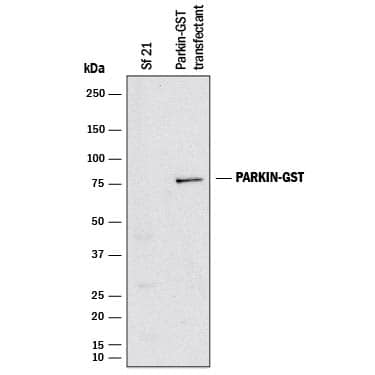Human Parkin Antibody
R&D Systems, part of Bio-Techne | Catalog # AF1438

Key Product Details
Species Reactivity
Validated:
Human
Cited:
Human
Applications
Validated:
Immunohistochemistry, Western Blot
Cited:
Immunohistochemistry-Paraffin
Label
Unconjugated
Antibody Source
Polyclonal Goat IgG
Product Specifications
Immunogen
E. coli-derived recombinant human Parkin-2
Met1-Val437
Accession # NP_054642
Met1-Val437
Accession # NP_054642
Specificity
Detects human Parkin in direct ELISAs and Western blots.
Clonality
Polyclonal
Host
Goat
Isotype
IgG
Scientific Data Images for Human Parkin Antibody
Detection of Human Parkin by Western Blot.
Western blot shows lysates of Sf 21 S. frugiperda insect ovarian cell line mock transfected or transfected GST tagged Parkin. PVDF membrane was probed with 2 µg/mL of Goat Anti-Human Parkin Antigen Affinity-purified Polyclonal Antibody (Catalog # AF1438) followed by HRP-conjugated Anti-Goat IgG Secondary Antibody (Catalog # HAF017). A specific band was detected for GST tagged Parkin at approximately 75 kDa (as indicated). This experiment was conducted under reducing conditions and using Immunoblot Buffer Group 1.Parkin in Human Brain.
Parkin was detected in immersion fixed paraffin-embedded sections of human brain (cerebellum) using 15 µg/mL Goat Anti-Human Parkin Antigen Affinity-purified Polyclonal Antibody (Catalog # AF1438) overnight at 4 °C. Tissue was stained with the Anti-Goat HRP-DAB Cell & Tissue Staining Kit (brown; Catalog # CTS008) and counterstained with hematoxylin (blue). View our protocol for Chromogenic IHC Staining of Paraffin-embedded Tissue Sections.Applications for Human Parkin Antibody
Application
Recommended Usage
Immunohistochemistry
5-15 µg/mL
Sample: Immersion fixed paraffin-embedded sections of human brain (cerebellum)
Sample: Immersion fixed paraffin-embedded sections of human brain (cerebellum)
Western Blot
2 µg/mL
Sample: Sf 21 S. frugiperda insect ovarian cell line transfected GST tagged Parkin
Sample: Sf 21 S. frugiperda insect ovarian cell line transfected GST tagged Parkin
Formulation, Preparation, and Storage
Purification
Antigen Affinity-purified
Reconstitution
Reconstitute at 0.2 mg/mL in sterile PBS. For liquid material, refer to CoA for concentration.
Formulation
Lyophilized from a 0.2 μm filtered solution in PBS with Trehalose. *Small pack size (SP) is supplied either lyophilized or as a 0.2 µm filtered solution in PBS.
Shipping
Lyophilized product is shipped at ambient temperature. Liquid small pack size (-SP) is shipped with polar packs. Upon receipt, store immediately at the temperature recommended below.
Stability & Storage
Use a manual defrost freezer and avoid repeated freeze-thaw cycles.
- 12 months from date of receipt, -20 to -70 °C as supplied.
- 1 month, 2 to 8 °C under sterile conditions after reconstitution.
- 6 months, -20 to -70 °C under sterile conditions after reconstitution.
Background: Parkin
Long Name
Parkinson Disease [autosomal recessive, juvenile] 2, Parkin [PARK2], transcript variant 1
Alternate Names
AR-JP, PARK2, PDJ, PRKN
Gene Symbol
PRKN
UniProt
Additional Parkin Products
Product Documents for Human Parkin Antibody
Product Specific Notices for Human Parkin Antibody
For research use only
